I’m an Australian biologist, conservationist, educator, writer and doomer who would like to take decent people on a journey. If you’re a doomer you will already understand and none of what I’m going to say will especially surprise you. You will already have seen all this in your own part of the world and you might be reading out of kinship with me and for qualities like sanity, honesty, integrity and love. If you’re not identifying as a doomer, I recommend some homework to you to dispel some stereotypes of what a doomer is and is not, why, and what doomers actually do with their lives. I wrote this love letter to the doomers within half a year of coming across people self-describing as doomers online, and getting into a supportive community with a group of those people.
If you’re not identifying as a doomer, this whole piece, however many instalments and postscripts I am going to write, can be your homework should you wish to engage seriously; and I will link you to other bright articulate people’s work for extended reading along the way. If you’re not identifying as a doomer and are merely here to search for ammunition and/or to preach to those who have seen more than yourself about things you do not understand, please be advised that there are standards for my comments section and that disrespectful, entitled, conniving people won’t get any oxygen there. Life is too short.
If you’re here to learn, I want you to know that I’m not writing to convert you, I’m just letting you look into my head and my heart, and vicariously walk in my shoes a while. It gives me no joy at all to see what I see and to think that if only people had properly gotten their act together even 35-50 years ago, things might have been different. It’s like getting a terminal cancer diagnosis, except it’s so much worse because it’s not just you, and not just your species.
But I had a friend with terminal cancer who amazed me by how she lived deeply in the time that was left to her, and made all the right choices day to day. She is a shining example in a constellation of shining examples I’ve been lucky enough to know in my lifetime. Some of the light in the pieces I write is their light, going on even after they have ceased to exist; just as some of the points of light in our night sky are the photons still travelling even as the far, far, faraway suns that gave birth to them have collapsed long ago. I write hoping to pass collective light on to other people who badly need light and warmth, and I give no quarter to sneery mean-spirited people who lack empathy, compassion, self-reflection and humility and are the worst examples of Homo colossus – which had the hubris to name itself Homo sapiens and automatically think itself above all other living beings in our world (and also above others of its own species).
If you’ve read my love letter, you know there will be photographs and music. This will not be a wall of text; this will include visuals, music and poetry for space and reflection. These things will organically fold into the narrative as needed. You will be welcome to submit your own experiences, thoughts, music etc in the comments section. Also constructive feedback and points of divergence, done respectfully. This means: Be informed before you post and use good manners. Comments that don’t satisfy those simple criteria won’t appear.
If you’re a greenwasher trying to “educate” our community about how renewable energy will save us etc, your comments won’t get in because you haven’t done your homework and are wasting everyone’s time. If you wish, you can do your homework at Deep Green Resistance, who have spent a lot of time writing cogent analysis of our predicament and have an introductory text online here as well as the book Bright Green Lies which I highly recommend for its critique of the non-solutions being peddled to us by governments, corporations and the bright green environmental movement.
I will begin with some light, and a song about the Milky Way, which most of us can see on a clear night from anywhere on this globe. There are lovely visuals in this clip (if the ecologically aware among you can ignore the intermittent monocultures) which I would like people to use in order to reflect on the deep beauty of nature and the sheer miracle of being conscious to experience that.
Next I have a hiking diary excerpt – because I want to start this journey I’m taking you on with something that is mostly about things that are beautiful.
March 20, 2021
STARLIT BEACH WALKING, COSY CORNER
What do you do when a heatwave makes it impossible to do daytime hiking even though it is autumn?
We’ve got a late heatwave in Western Australia, where it’s impossible to do a hike in the middle of the day, which made me think, “There goes the weekend!” as the cool change wasn’t coming till Monday. So we did useful things around the house and outside (brief stints into the heat, like skin diving when you’re holding your breath, before coming back in to cool off) in-between recreational indoors tasks. A whole list of things was done between us by evening: House cleaned, laundry done, garden watered, all the stock troughs cleaned and filled, the nine honey frames from one super extracted – I was uncapping, Brett was spinning with our little two-frame hand spinner, end result was 20kg of honey but it does always take hours (CDs and iPod type activity). I did the daily supplementary animal feed at dusk and noticed the sky was clear, with a low half-moon; also the heat was finally subsiding for the day, and it gave me an idea…
So after flying my idea over dinner, we drove to our nearest beach for a night walk. Last time we tried to do this we ended up nearly freezing in a cold wind, having come unprepared for an Antarctic blast in mid-summer; also there was a bit of cloud cover. But last night, there was only the gentlest of breezes and it was still 19°C at 9pm. The sky was completely clear and the moon had dropped below the horizon – and this is the Southern hemisphere, 400km from the nearest large city, so what you get on such nights is a black velvet sky with luminous crystal-like stars.
The Southern Cross hung relatively low over the southern horizon and waves rolled in beneath it in the wide bay at Cosy Corner, the surf illuminated by starlight. You’d be amazed how bright moonless nights can get where we are – after starting with the red light on our head torches to get down to the beach, we switched that off and walked as our eyes adjusted. (Red doesn’t interfere as much with the development of night vision – don’t use a white light when you go do this because you don’t have proper night vision for around 20 minutes after removing yourself from that kind of light.)
This is the general view we had…

…except that’s just a diagram; in reality the stars look more like this:

I never used to see it like that in the Northern hemisphere as a kid; too much light pollution in Europe and you need cameras with long exposure to get a look at the smaller points of light there – but not where we are; the clarity is amazing. We were thinking that it’s so sad that since the invention of the Edison bulb, so few Westerners ever see a proper starlit sky – if they’re not confining themselves to the indoors at night as is the cultural norm, and actually make a point of going walking at night, the light pollution from others cuts the view down so much in many places in the Western world.
Night walks are great for other reasons too – during the day, the majority of our brain’s processing is visual. In the dark, other senses kick in far more strongly. I’m guessing most people reading know the difference between listening to music in daylight versus sitting quietly in the dark – now apply that to the outdoors…it’s amazing how much you become aware of what you’re hearing, and of the scents around you, and how your internal GPS activates when you’re walking in the near-dark.
We walk around the tracks of our on-farm bushland at night a lot, and you can really hear the crickets, the various different frog species, the odd chirp from a roosting bird, leaf rustling if there’s a breeze, and the low range of the calls of the hunting microbats – as well as some of their wing flapping when they get close! Also, the smell of Lemon-Scented Gum (a eucalyptus tree) on a still night is an incredible experience – it’s one of our favourite smells in the world, and especially extraordinary when your brain doesn’t have the usual background noise of daytime visual processing going on.
A night beach walk too is a totally different experience to going there by day, even on an overcast night. You become aware in ways we’re not normally aware in everyday Western life. But on a starlit night, the universe is right there, without a curtain of clouds or daytime Rayleigh scatter (which gives us our blue sky). You can see beyond “Earth view” into “here we are in the universe” view – and you go from, “Look at all these amazing things everywhere!” to, “All this stuff around us is really small by comparison, as are we…”
Now add to that a little reflection on the speed of light and that when you look anywhere, you’re always looking into the past – even when you look at your foot, the image is slightly in the past because of the tiny delay from the photons travelling from your foot to your eye. Across the vastness of space this becomes super significant – if you turned off our sun, it would take 8 minutes for us to notice – and the distant stars are many light years away. Sirius, which you can see from both hemispheres, you see where and as it was nearly 9 years ago when you look up at it. The Magellanic Clouds we get in the Southern hemisphere are around 200,000 light years away, so that’s how old the image is that you see of them – and Andromeda, if you see it, you see where and as it was 2.6 million years ago…
If you do ever stand on the seashore looking at stars, you’re essentially looking at two cradles without which you would not exist:
1. Because all of us are made from what we can romantically call “stardust” – as the heavier chemical elements from which we are composed, such as carbon, oxygen, nitrogen, sulfur, iron – were all formed from the nuclear fusion of lighter ones like hydrogen and helium at the cores of suns, in a process called stellar nucleosynthesis – more fun reading about that here; and
2. Because our ancestors crawled out of the sea…
♦ ♥ ♦
You can find other places of beauty and sense in my South Coast Wilderness Walks photoessays on this blog, which this excerpt is from. I started that series for overseas people who have never seen a proper Australian remnant ecosystem and are interested in vicarious guided walks in some of the few remaining comparatively unspoilt wild places left on the planet. Because this is the normal we have lost, this is the world as it used to be, before our industrial civilisation started to destroy it rapidly.
And so many modern people are utterly divorced from nature these days; they grow up in captivity, in a human zoo. Desmond Morris wrote a book of that name in the late 60s, that’s worth visiting for those who haven’t read it – its observations about modern humans are both humorous and grotesque, and give us some pieces of the puzzle of Homo colossus.
Another puzzle piece is so well described by what a friend wrote to me today:
Where your essay really hit me was when you spoke about “the veneer of our civilisation”. It reminded me of the chorus in a song by the group Animal Logic: “What looks good on the outside may be falling apart on the inside”. It seems to me the purpose of that veneer is twofold. It’s a great cover for hiding from one’s cognitive dissonance. But even more so, it is the camouflage for our society’s now-rampant mental illness. Hiding in their houses, in their phones and TVs, in the fog of their inebriants and antidepressants, and the euphoria of consumerism, people are so far removed from the real world that they see it as strange and unfathomable, while their plastic-wrapped ultra-vivid meta-verse seems like reality.
And as I’ve discussed with him, those who live close to nature and physical reality are mostly outcasts in our civilisation, often seen as primitive or backward (in the case of Indigenous cultures especially; our culture falsely assumes superiority), and/or esoteric and quaint (not to mention wrong) if they are people who are delineating themselves from mainstream industrial culture and/or engaged in its critique.
Here’s a song that to me really sums up the nausea of dealing with where we are finding ourselves, we who were born into dystopia and understand that this is the case; that dystopia is not just for novels or for other people or in the future. We are in the future and we are those people.
Destination (by The Church)
Our instruments have no way of measuring this feeling
Can never cut below the floor, or penetrate the ceiling
In the space between our houses, some bones have been discovered
But our procession lurches on, as if we had recovered.
Draconian winter unforetold
One solar day, suddenly you’re old
Your little envelope just makes me cold
Makes destination start to unfold.
Our documents are useless, or forged beyond believing
Page forty-seven is unsigned, I need it by this evening
In the space between our cities, a storm is slowly forming
Something eating up our days, I feel it every morning.
Destination, destination.
It’s not a religion, it’s just a technique
It’s just a way of making you speak
Distance and speed have left us too weak
And destination looks kind of bleak.
Our elements are burned out, our beasts have been mistreated
I tell you it’s the only way we’ll get this road completed
In the space between our bodies, the air has grown small fingers
Just one caress, you’re powerless, like all those clapped-out swingers.
Destination, destination.
Next I want to take you on another trip; a recent trip up to our state capital for the first time in nearly a decade, traversing back roads in agricultural areas where I haven’t been for 20-30 years. Some necessary background first: As a young Env.Sc./Biology graduate 30 years ago, my first paid assignment was in a land sustainability team with the West Australian Department of Agriculture. I was in a group working on a focus catchment for secondary salinisation, one of the many problems associated with land clearing and broadacre agriculture in much of Australia that interfere with agricultural productivity and further degrade the bare bones of landscapes left behind after large-scale clearing, which was long-standing government policy in Australia and compulsory if agriculturalists didn’t want to lose their titles. I will get into the insanities of colonialism, terra nullius and the idea of owning land at some point in this series, but for now I will stick to discussing the job I was employed to do.
I was the top graduate from my university biology programme and already an accomplished writer, so I landed with both fieldwork and writing up the entire project for the benefit of other scientists in other catchments, and landholders in the focus catchment. My part of the fieldwork was to conduct a soil and land capability survey and to interview local farmers to learn from their personal experiences of working with the land and get their views on systemic problems they were facing in reducing the problems and improving the sustainability of their land use.
The other part of my work was to collaborate with and learn from hydrologists, soil scientists, agronomists, crop and pasture specialists, landcare/land revegetation and rehabilitation professionals, ecologists who had done regional biodiversity surveys, and various other staff working in government agencies, to come up with a set of catchment management recommendations to improve the sustainability of agriculture in our focus catchment and, by implication, in similar degraded catchments all around Australia.
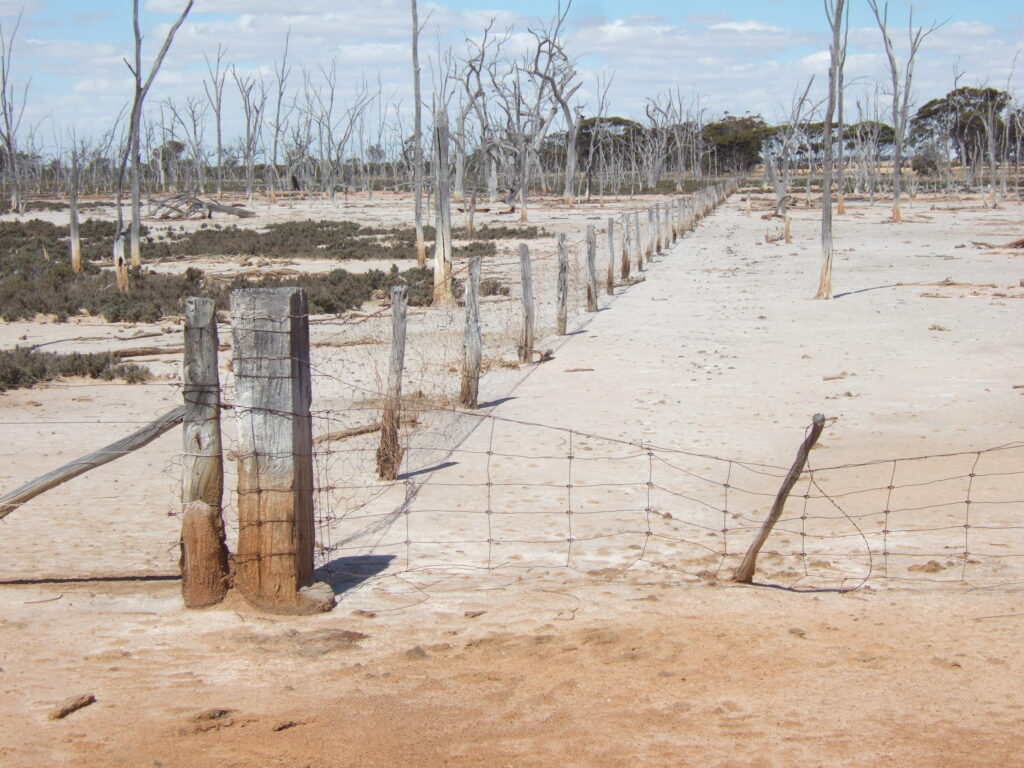
I finished a comprehensive report 18 months later that received the widespread acclaim of the landholders, my colleagues and collaborators, and my supervisors. Many landholders were dead keen to implement the recommendations (which I will discuss later, when I will show you the problems), but needed structural and logistical support that the government was unwilling to give. The government wound down the landcare programmes over ensuing years and gave the tax money of Australian citizens to tree monoculture corporations for so-called environmental work instead, robbing the local communities who needed help and enriching political mates who already had deep pockets, in yet another example of how money is transferred from average people to the rich and the corporate in our country, and many other Western countries.
And of course, the environmental benefits of tree monocultures are marginal at best, and negative if you take into account all the fossil fuels and mining required for the operation of industrial tree farms and their machines, and the manufacture and running of trucks, roads, harbours, cargo ships, more trucks and roads for the transport of woodchips, and pulping factories that turn them into paper products (the end product of our region’s blue gum plantations); and then more global transport and further manufacturing of those products; not to mention the toxic load that is added to the environment through all of these processes. Those are the apparently invisible elephants in the room; and the mammoth amongst these strangely invisible entities is the wholesale ecocide carried out on a daily basis when the earth’s few remaining patches of remnant ecosystems and precious wildlife habitat are further degraded by logging, extracting and wholesale bulldozing them (for suburban sprawl, mining, agriculture and industry), and lately by covering vast areas of remnant ecosystem in solar panels and wind farms, which the bright greens falsely believe will save us.
With that in mind, enjoy a well-deserved musical break with an astute and topical clip from 1988, then come with us on a road trip to some agricultural areas of Australia’s southwest (and in a later instalment, to our glittering metropolis).
♦ ♥ ♦
Albany to Perth via Lake Towerrinning, Darkan, Williams
Our first stop on this trip was at Lake Towerrinning, half an hour northwest of Kojonup, a nature reserve, camping area and recreational lake in cropping, sheep and beef country. We hadn’t been there in nearly a decade and noted the construction of a long shoreline boardwalk. It seemed to us an unnecessary construction; previously we had walked down to the lake beach on one of the paths down from the car park and from there walked on the actual beach. We wondered how many trees had been logged to make this boardwalk, and more generally why it is that our culture can’t seem to enjoy a lake without constantly making “improvements” to it, or using noisy fossil-fuel guzzling motorised recreational toys on it.
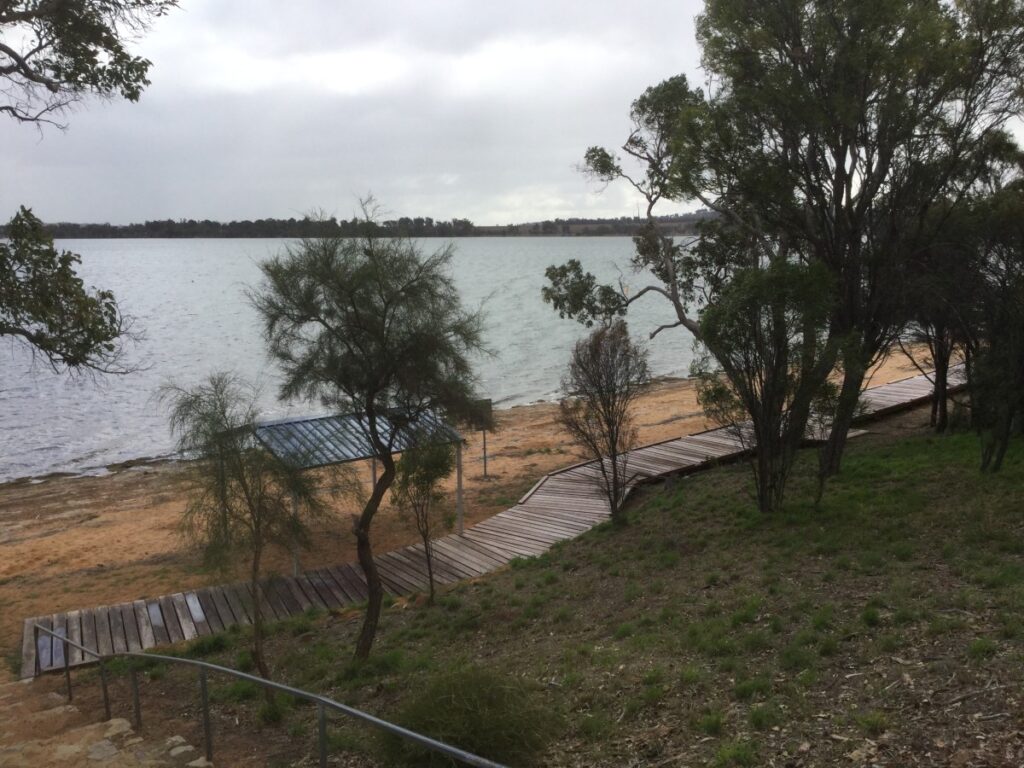
We personally don’t need picnic tables, BBQs, boat ramps, lawns and many other “must-have” facilities our culture puts up at lakes. We bring our food in our backpacks and sit under a tree or on a rock to eat. It goes without saying that we take out any rubbish, and that we aim to minimise our production of rubbish in the first place by bringing our own food and drink containers. For recreation we walk on the shore, maybe wade or swim, enjoy the landscape, tell each other stories, play impromptu word games, look at vegetation, insects, birds, etc.
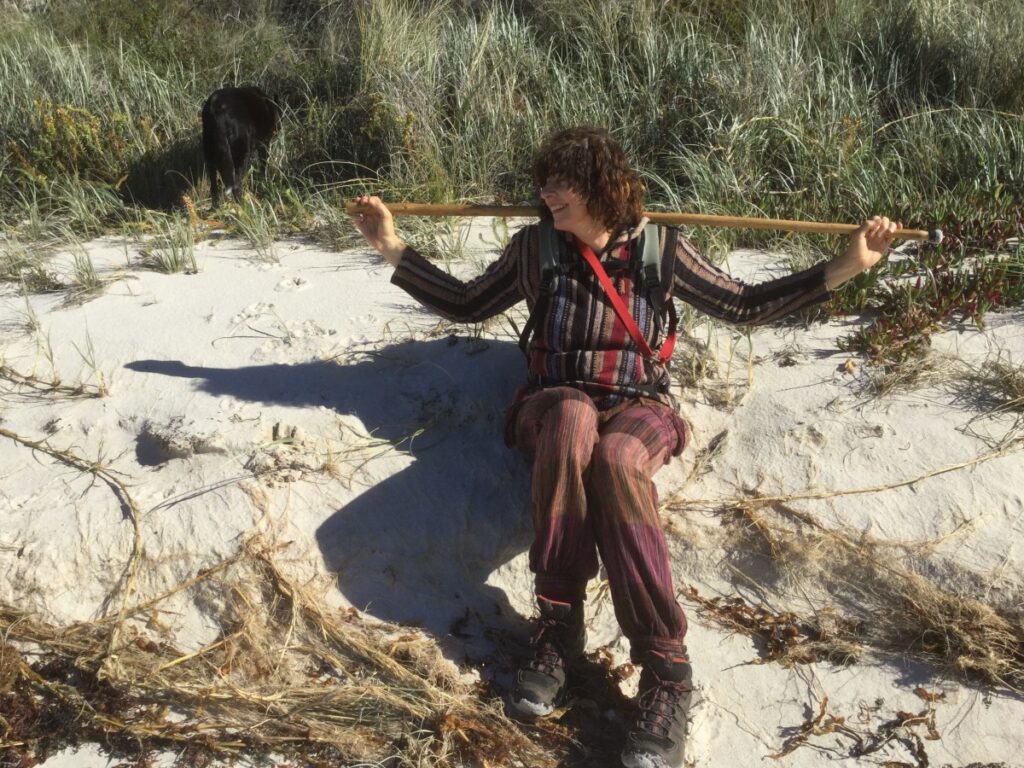
The Noongar people, who lived in this area for over 50,000 years, were many light years ahead of us in footprint reduction as, before their dispossession by our culture, they lived directly off the local ecosystems in a balanced manner, had completely locally sourced, biodegradable, non-toxic food and drink containers, tools, habitations etc, and walked everywhere. They also limited their own numbers from going above the carrying capacity of the local ecosystem by actively preventing excess births. If they hadn’t done this there wouldn’t have been enough food to go around and they would have starved and/or damaged the ecosystem. You can read in the above link about their culture and their core belief in responsibility to country, which our own culture is so sorely lacking.
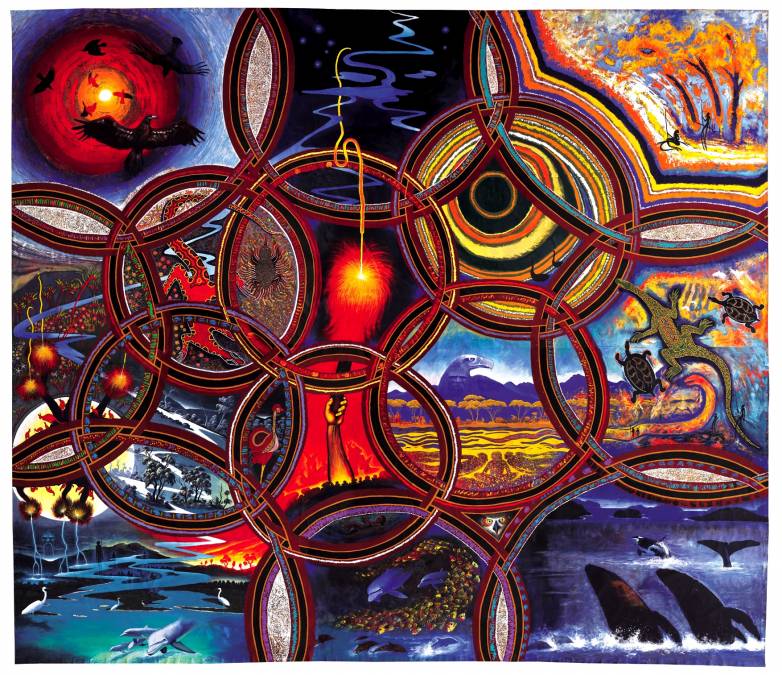
By contrast, Homo colossus is in extreme overshoot but largely buffered from witnessing and having to live with clearly identifiable consequences in their everyday life, for the moment. Much of the destruction happens away from the average person’s backyard, and most people in “developed” countries now live in human feedlots/CAFOs (cities) and see that as normal and sustainable. They may see suburban sprawl at the city fringes and some may object to it, but they don’t see the majority of the habitat destruction, pollution, social injustice and senseless resource waste that happens all over the globe in order to bring their food and consumer goods to them. If they do ever see photographs or reports of the environmental damage (or indeed the suffering of the poor and powerless of their own species), they don’t usually make the connection between their purchasing and this damage – it’s something terrible happening elsewhere and nothing to do with them. In their world, food magically appears on the supermarket shelves, consumer items do the same in various other shopping outlets, rubbish and “recycling” goes into bins, all of this is normal, and day to day things look much the same around them. Human brains mostly notice their immediate environments, and city dwellers are habituated to their concrete jungles, suburban Legolands and shopping complexes. It is their ecosystem – except it’s not an ecosystem, it’s an industrial feedlotting operation. The average human no longer takes responsibility for their own food production or waste products. Hardly anyone finds that alarming.
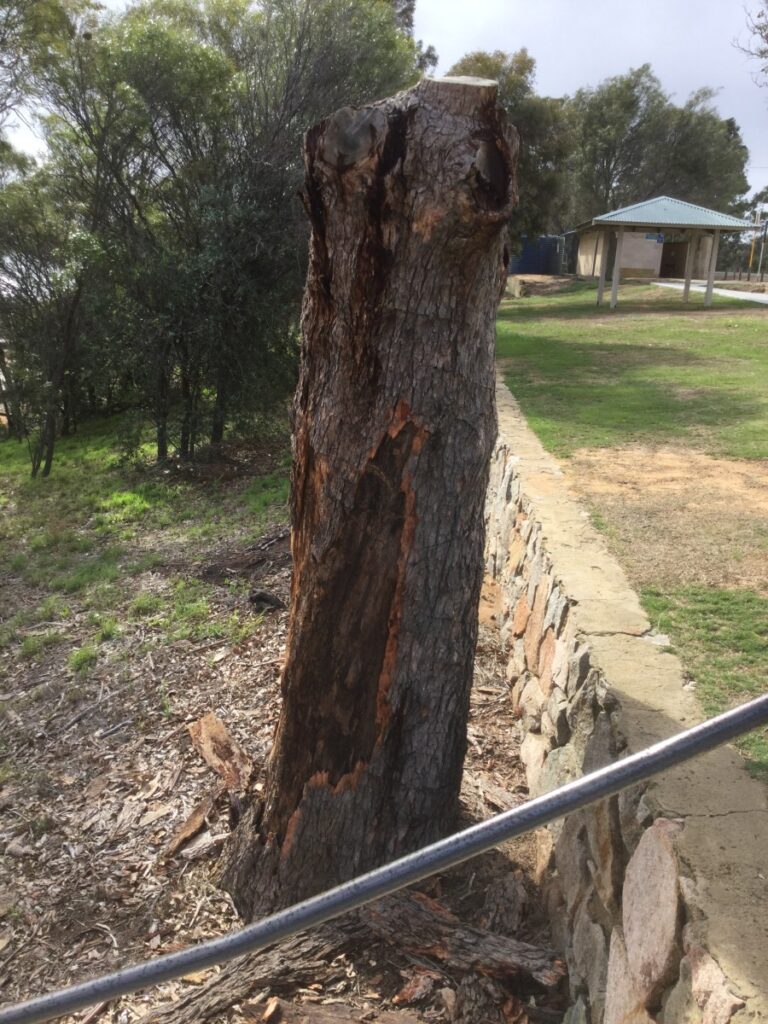
For the above photograph, I would like you to do a little mental experiment. Here we have a dead tree which was in all probability either killed by landscaping operations (and then had its top cut off because we live in a culture where people sue others if a branch falls on their head), or cut down to stop its roots from fracturing the retaining wall (which wasn’t needed before the lake environment was “improved” by our culture). Most visitors would barely notice this going up and down the steps to the lake. But if it were a dead kangaroo lying there?
Homo colossus is very blind to the deaths of living beings that don’t look very much like them. Also the average person isn’t conscious that the loss of a tree is a loss of habitat equivalent to bulldozing a tower block in a city. Many thousands of homes are lost when a tree is cut down, as well as sustenance for many thousands of creatures. To say, as many will when you bring it to their attention, “But there are many trees and they can just go to another tree!” is like saying to the erstwhile inhabitants of the tower block, “But there are many tower blocks in this city and you can just go to another one!”
You could plant another tree, and it would take over 30 years to become equivalent habitat. The original tree would by then have been over twice that age and even better habitat. And how many consider what goes on underground? In nature (as opposed to tree monocultures), trees are connected to other trees and understorey species, and indeed their entire ecosystem, in a physical network mostly mediated by symbiotic fungi. For an exposition of this, I highly recommend Merlin Sheldrake’s Entangled Life.
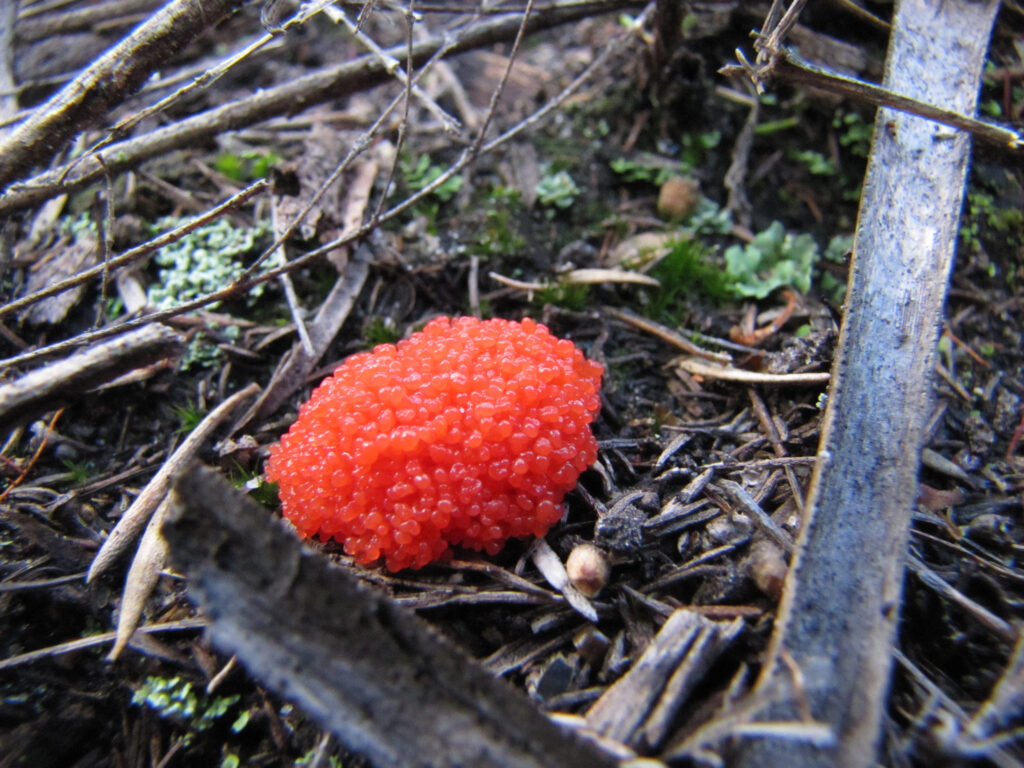
There is also in Homo colossus a hierarchy of care that starts with me myself I at the top of the ladder, followed by family and friends, then other people who look, talk and act like them, then maybe people who look, talk and act differently, and cute cuddly animals. Most modern people who aren’t gardeners or farmers barely consider the lives of plants, let alone the notion that plants have intrinsic value and that plant species have as much of a right to exist as we do, or that in the gross hyperinflation of the human population and its rate of consumption per capita since industrialisation especially, humans have destroyed the majority of natural forests, woodlands, prairies etc the world over, and wiped out over half the plant biomass. This hierarchy of care is incompatible with the circle of life in the biosphere. We are now in a mass extinction event caused not by meteorites, but entirely by humans.
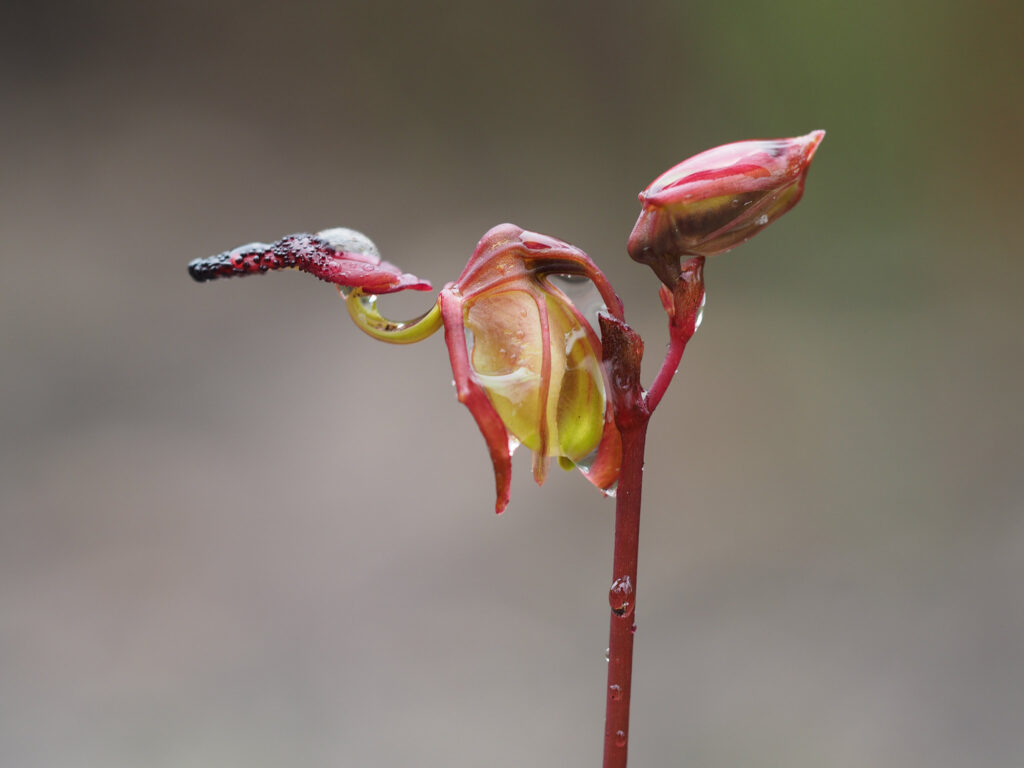
Try getting Homo colossus to care about invertebrates or fungi or microbes, or anything they think of as “yukky” or “dangerous” – the latter is kind of ironic; Homo colossus is the most dangerous species to have ever existed on the surface of the earth, both to other living beings on this planet and to each other. There’s a lot of shadow projection going on in middle-of-the-road movies about aliens, who are frequently portrayed as a threat to humans, rapacious, seeking conquest. From the perspective of the rest of the biosphere, we are those rapacious, bloodthirsty aliens and we’ve eaten most of the fabric of life on this planet in the last few centuries.
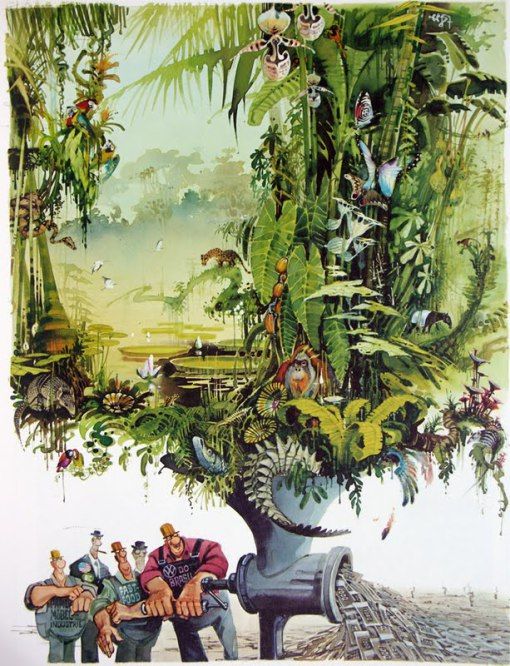
Though often regarded by fellow doomers as “exceptionally mediocre”, VOID members are easily able to see what happens when frenzied and delinquent apes, fuelled by oil and flames, run rampage on a fragile and fertile world, making it an image of their ghastly industrious minds.
(Donald McCarthy, Irish doomer)
I took the photo below just before we left Lake Towerrinning. The Landcare sign by the car park is 30 years old. You might have read about the Lake Towerrinning diversion project in the link posted earlier. I’d like to go back to pre-colonisation. This lake was much smaller then and its riparian vegetation intact. Between 1900 and 1950 much of the surrounding erstwhile marri-wandoo woodland and yate flats were broadacre cleared for agriculture. This caused the lake to get much bigger. And some might think this is a good thing, but the extra water that is in the lake was meant to be in the bodies of living beings. It was meant to be in blood and lymph and sap and to be evaporated back to the atmosphere to benefit drier inland areas, because life supports other life – with the exception of Homo colossus, who treats life like a commodity and takes it for himself and for profit.
The native vegetation that was cleared used to intercept, use and recycle precipitation (and in dry periods pump groundwater) and transpire it back to the atmosphere. It also used to support plentiful breathing wildlife that helped humidify the air. This moisture could then move on the prevailing wind, condense and fall as rain further inland. Ecosystems like this create their own rain. Homo colossus wipes them off the face of the earth to grow crops and pastures, make roads and suburbs and industrial areas and mines. He calls this ecocide development. Billions of living things are killed directly or indirectly, species fall off the cliff of extinction, the water table rises and causes waterlogging and salinisation, the extra surface runoff causes soil erosion, waterway sedimentation and eutrophication (=algal blooms, fish kills etc), and a massive drop in plant transpiration causes reduction in rainfall inland of the cleared areas. Deserts and wastelands follow in the wake of agriculture.
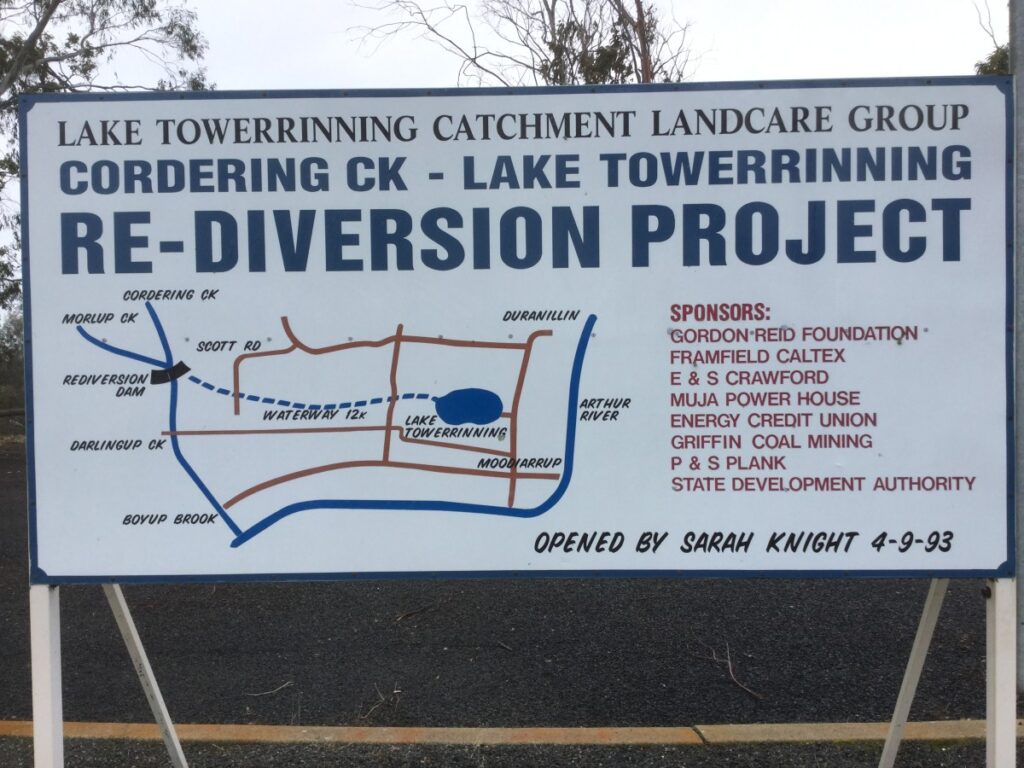
By the 1960s Lake Towerrinning was getting saline. Because this threatened local fish and bird species, not to mention what was left of the lake ecosystem, channels were cut to drain saline water from the lake and to divert fresher water from other surrounding areas into it. It was a typical technological solution to fix a problem created by our culture in the first place. For tens of thousands of years Lake Towerrinning did not have a salinity problem. In under a few decades post colonisation and land clearing, that and so many more things changed.
Many accolades and awards were bestowed on the people behind the water diversion project, which lessened just one of the many problems created by our abuse of the environment. It’s nice to give recognition to people who get together to try to change something for the better, but we tend to forget in those paltry victories the sheer size of the disaster we have created. We do not go nearly far enough; we do not stop the wholesale abuse, we only ameliorate the odd selected issue here and there.
You may have read in that link that Lake Towerrinning is considered to be an important habitat supporting many species of waterbirds. It says: “The area is an important habitat for a large range of species, including 14 species of frog, 43 species of reptile, 171 species of bird and 23 species of mammal. It is a wildlife refuge that supports a large population of birds, both local and migratory. The lake is recognised as an Important Bird Area by BirdLife Australia for the population of blue-billed ducks it supports. Other birds that can be seen are Australasian bittern, black cockatoo, peregrine falcon and the eastern great egret. Many reptile species have also been recorded around the lake, including the long-necked tortoise.”
We have been to this lake at least a dozen times in our lives and never observed any flocks of waterbirds, schools of fish, gangs of cockatoos, etc. We’ve barely spotted a single fish or pair of birds, have never seen a frog or tortoise or tadpole there. We see more songbirds in our own garden. This is not to say these animals don’t exist at Lake Towerrinning. I helped to conduct fauna surveys in conservation parks as part of my training and know that you need to be in an area at certain times and 24/7 and be wily to come across the majority of vertebrates that live there. This is normal – but it is not normal. This is the brave new world Homo colossus created. We are living in a vastly biologically impoverished world, thanks to our civilisation and its centuries-old habit of wiping other beings off the face of the earth. Even in conservation reserves, the wildlife you see is a pale shadow of what it was before the age of machines.
In the diaries of the European explorers who brought our pestilence to America, Africa, Oceania etc, frequent mention is made of flocks of birds that cover the sky and block out the sun, of waters so teeming with fish that the locals would catch their dinners with a spear in a very short time, of dense clouds of butterflies that filled whole forests. These were not fanciful notions; this was the world before our civilisation annihilated most of it. The world used to be abundant with life. Now it is turning into a stagnant cesspit that was long since overpopulated with Homo colossus.
I am a child of the cesspit and the silent world, living on a remote edge of a continent that was one of the last places to be “civilised” by the European culture. I marvel at the old-growth forests and ancient woodlands and heathlands through which my husband and I are incredibly fortunate to be able to hike on a regular basis. These are some of the best remnants left on the planet of what used to be; the echoes of a world I never knew and wish I had, just as the children of today will never see the natural world as it was when I was a child, and would scarcely believe what I saw when I was their age, because these are things that have disappeared forever. When I was 12, the nightly deafening chorus of many different frogs in a nearby wetland long since degraded, the sight of oxbow swamps teeming with tiny fingernail-sized frogs that literally carpeted the place, the windscreens so covered in insects in a short distance of driving that people had to stop and clean them off several times on a trip to town.
40 years later I live in a faraway place on a remote coast, surrounded with more remnant vegetation than is left in most places in Western Australia’s Southwest, and though I can hear frogs outside in the nearby swamp as I type this, it is a pale shadow of the sounds I heard as a child. We hear many birds all day here and some of the night, but I remember large flocks of black cockatoos in my early 20s flying over Middleton Beach and Mt Clarence in Albany town, screeching en masse so that you would stop what you did and turn your face towards the sky with your hair standing up all along your arms and neck. To me that was a spiritual experience. The black cockatoos are endangered now, and though they visit the 50 hectare conservation area we moved here to steward, they come in small groups, never in the numbers I used to see them in during the early 1990s when I first came to the South Coast.
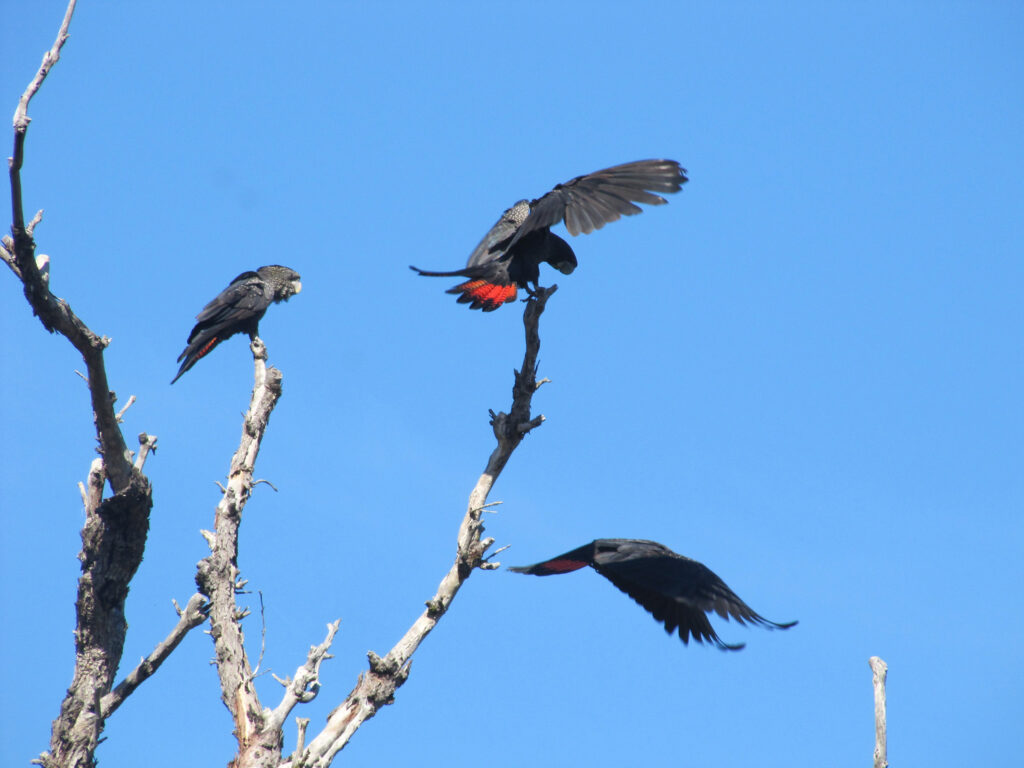
And that was a fraction of how they were experienced by a late friend who grew up here in the 1940s, and that was a fraction of how they were experienced by the first European explorers, and by the Noongar people who lived here for tens of thousands of years.
People have given lip service the whole of the last 30 years since I became an environmental science professional to the notion of conservation and being environmentally friendly. And the whole time, every major indicator on biodiversity has been declining, and more and more toxic industrial chemicals contaminate not just our blood but every living thing and the whole planet, and there is now nearly as much plastic in the oceans as fish, and the sum of human-made materials is now heavier than all the world’s wildlife, and the climate has now passed tipping points. The runaway train of destruction isn’t even slowing down, it is accelerating. The train is driven by psychopaths and most of the human passengers are either cheering or are unwitting enablers – including the mainstream environmental movement.
On that cheery note, I will break for a much-needed interval. Next time I am inviting you along to the inland agricultural areas between Lake Towerrinning and Williams, and later to some of the Darling Range state forests and conservation reserves southeast of the Perth metropolitan area. We can talk land management, conservation, farming, and general doom. Also music, poetry and a few other things.

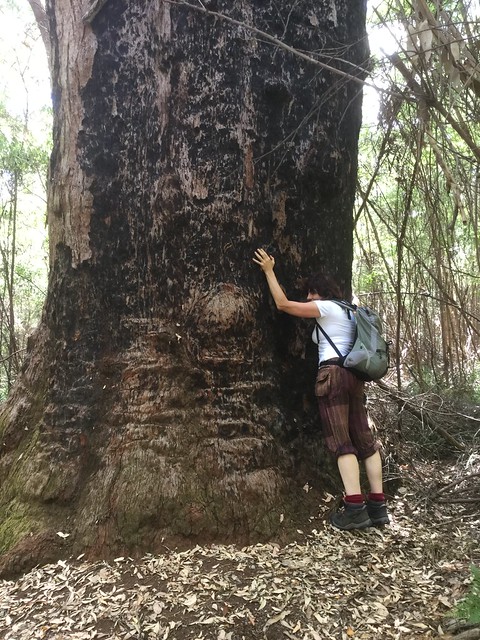

Beautifully crafted, Sue. Just when you think there is nothing to be said, along comes a quiet voice speaking sense to the chaos. I do like how those of us who howl and bark probably learn as much from you as you from us. Maybe the calm voice stilling the storm is always female? Who knows. You’re a mighty woman for one woman, as we say here.
Thank you, Donald.♥
I still think you should get this year’s Doomer Prize of Book.😉 That howling and barking in print, and your doom reflections in general, are incredibly therapeutic. Maybe it’s the rage, rage against the dying of the light thing. Without anger in response to outrage, we only have depression. Anger gives you energy to go kick a deserving behind, and plant some trees to boot. To do what you have to do, when love is not enough, or you don’t want to cast your pearls before the swine (with apologies to actual swine🐽).
I may write calmly but if you were a fly on the wall you would see me ranting and turning the air blue on a regular basis!😄
One thing that being female does do for my writing is that I’ve got no conditioned cringe when it comes to expressing more vulnerable emotions. You know Sam cringed because of his social conditioning when he read my doomer love letter on Collapse Chronicles and thought the middle of it was TMI, but I’ve spent so much time on mental/emotional health stuff because of my own cPTSD and because I was the mad but warm aunt to adolescents from sometimes really awful backgrounds for a big chunk of my life, so I know 100% that these things so many males especially find uncomfortable absolutely need to be aired. The silence suffocates and so many people quietly despair. All of that has been playing into the hands of controlling the masses too, and allowing the kind of corruption we see in the so-called “high places”…it’s all interrelated. Breaking the silence helps make it less scary for others, and helps the people sitting in the shadows understand their own stories and find their own voices.
It’s not an overstatement to say that what pulled me out of depression late last year was reading the thoughts of yourself and Ian on matters pertaining to doom. It made me laugh with gallows humour, and it made me rediscover some much-needed anger. The whole VOID contingent is the pub I like to check into to feel better – not for any beer, but for the people, the poetry, the calling a spade a spade, the black humour, the wonderful super-clever writing and the basic human decency.
Go raibh míle maith agat, you guys.♥
From your overseas Irish appreciator
Wonderful insights, writing, and music. There are many wild places on the planet that I’ll never visit, but their mere existence brings me happiness and comfort. I feel the same way knowing there are people scattered across the globe doing what they can for nature who share my views and trepidation. I feel extremely lucky to have met Sue on Twitter.
Thank you, Lyle.♥
I 100% relate to what you’re saying. And I’m grateful to have met you, and a whole bunch of other clever people who give a damn and don’t sugar-coat and obfuscate, on Twitter – of all places!😲
I know you’ve come to similar conclusions to me about the notion of changing a system from within. I honour that you tried for 30+ years, but Lyle, I have lately come to think that these people basically have lead deficiency, and that change often happens one funeral at a time. Sadly though, even that isn’t fast enough, plus that type is interchangeable and seems to breed prolifically and immediately attach itself to any vacant positions of power to continue the carnage and the insanity. Which is a large part of how we got here.
I’m not giving up the fight for decency. And there is a lesson in my old dog. I know I won’t have her 5 years from now, but we are making the short time we have left count. Just as I do with our food animals. It’s the same with hiking in the wild places of the coast on which we live.
Nature is a wonderful place of sanity and nurture. Such a contrast to our societies. I will keep on photographing the paths we’re hiking for the first time, and publishing them as vicarious guided walks so that other people around the world can also be happy about what is currently out there, alive and beautiful.😍
And I thank you and everyone else who is doing positive things in this rotten dystopia.♥
So wonderful to have you for my global neighbours and community.♥ ♥ ♥
Best wishes, also to Bee-Lady 🐝
Sue
Sue, it is beyond wonderful to walk in your shoes on this walkabout. Pockets of Nowhere is where there is still life to be found. Passing through the stages of grief with this gang of Gloomers underlines our collective tragedy that we both watch and helplessly participate in. No getting off the freight train. Thank you for sharing your soaring spirit, the voice of the Feminine is the most important one now. Never TMI as this voice has been silenced too long. I love the deep time stardust light illuminating your walk. Most humans in the feedlot can no longer gaze in awe at the heavens, or peel the bugs off their teeth smiling in the wind. I look forward to each precious second of sharing these end times with this clotch. Walk on.
😘
Dear Jan
Thank you very much for reading and commenting. ♥ I’d write it anyway even if there was nobody to read it, because writing is my space for meditation, serious thinking and putting things together. What is lovely after decades of writing for personal reasons and in personal spaces is when I put something out there and someone else actually finds something in it for them. I’m glad to be of service. As a reader I have obviously been deeply blessed with reams and reams of wonderful, thoughtful writing by the giants on whose shoulders I am standing as I look out on our broken world. It takes a village to raise a child; writers and musicians had such an important role in raising me and helping me make sense of what I was finding myself in.
Where would I even start acknowledging authors? With James Herriot, Enid Blyton, Lisbeth Pahnke, Josef Carl Grund from my childhood? Charles Dickens, Emily and Anne Brontë, Judith Wright, Jane Austen, WB Yeats, Thomas Hardy, ee cummings, anthologiser/poet Roger McGough, George Orwell, John Steinbeck, and many others, who were strong voices from my adolescence on? With Jeannette Winterson, Joanne Harris, Peter Høeg, Walter Macken, JK Rowling (/Robert Galbraith), Val McDermid, JP Delaney, Kaz Cooke, CS Lewis, John Wyndham, Haruki Murakami, Anna Fienberg, Kate Grenville, Tim Flannery, Neil Gaiman, and many more who I’ve been getting into this millennium? Elizabeth Bouvier, adopted sister and fellow blogger, who regularly scorches the paint off the walls about the state of society, and a number of other online activists on mental/emotional health and systemic oppression? Every single one of these diverse authors has in common keen intelligence and observation, a sense of justice, and a big heart. These are characteristics which are sorely lacking in Homo colossus as a species, and which you need to supplement yourself with in the company of cultural outliers.
My hat is off to all of them.
And to our online family of so-called doomers. I still think it’s ironic to be called this. It is Homo colossus collectively dooming everything and then wrinkling their noses and pointing their fingers at those who refuse to put on the rose-tinted glasses about it and get with the programme.
Best wishes from our little patch to your little patch, Jan. Hugs to Heloise and the Fjordies.
♥ Sue
Whew! Once again, I’m left speechless by your insights, photography and passion. I especially love the photos of the night sky…indeed we’re all stardust.
And cheers for including me in your world family sister. 💜
Much love always.
Hey Sis!♥
Not my photos and can’t find the metadata! Maybe I need to credit it as “Anon” (very prolific person, that!).
Thanks for popping by! Couldn’t have your ears burning, could we? I thought this paragraph of yours was perfect:
An honour knowing you.
♥ Sue